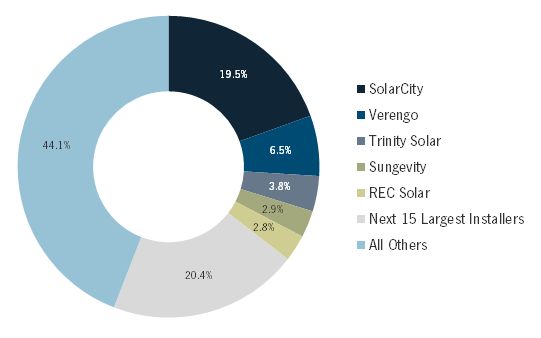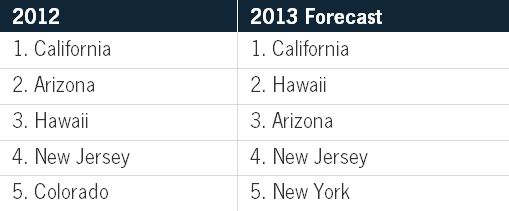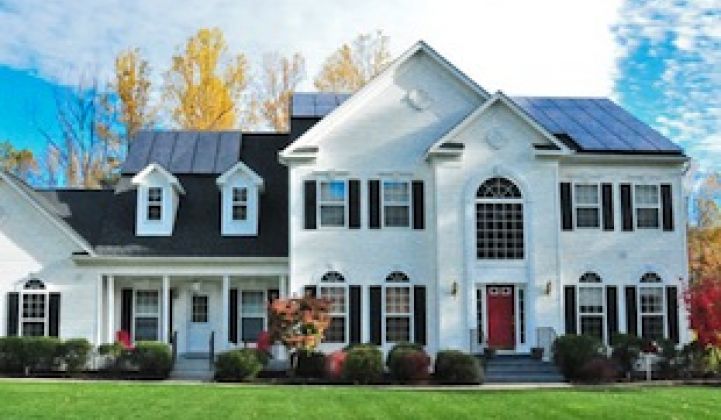A record 488 megawatts of solar was installed on residential rooftops in the U.S. in 2012, up 62 percent over 2011. SolarCity continues to dominate the market segment as an installer with an overall market share of 19.5 percent on the year (see Figure 1). A number of smaller installers have emerged, eager to capitalize on growing state markets and untapped consumer bases. The companies listed below all have yet to crack the top five in the GTM Research U.S. PV Leaderboard market share rankings, but their unique strategies and partnerships make them promising installers to watch in the coming year.
Figure 1. Top Residential Solar Installers, 2012*

Source: GTM Research U.S. PV Leaderboard
*Note: This data tracks installers, not service providers; financiers such as Sunrun and Clean Power Finance do not appear in the rankings.
1. Astrum Solar
Founded in 2007, Astrum took off in 2011 after an investment from Constellation Energy gave this East Coast installer a guaranteed SREC offtaker in certain markets and allowed it to begin offering a solar lease in six of its twelve active state markets. According to Inc.com, it is now America’s second fastest growing private company. Not solar company -- private company, period. Astrum was the number-one residential installer in Massachusetts in 2012, and in September it secured a megawatt of guaranteed business through Solarize Mass, a program through which installers bid to deploy solar projects in participating communities. The key to Astrum’s success in 2013 will be New York, which is expected to surpass Massachusetts and Colorado to become the fifth largest residential solar market (see Figure 2). In 2012, Astrum quickly became number two in the state, capturing 14.9 percent of the market. Although the company lagged behind SolarCity’s 15.3 percent, Astrum is poised to stay ahead of those firms, which were late to enter New York.
Figure 2. Top 5 Residential Solar Markets

Source: U.S. Solar Market Insight: Year-in-Review 2012
2. GRID Alternatives
GRID Alternatives is particularly interesting to follow, as it is by far the largest nonprofit solar installer in the country. The company serves as the sole administrator of the Single-family Affordable Solar Homes (SASH) Program, part of the California Solar Initiative. GRID uses funding from SASH’s $108 million budget to fund installations for affordable housing organizations. Volunteer labor and donated or discounted modules from Yingli, SunPower, and other partners help stretch this budget to fund as many systems as possible. It is no surprise, therefore, that GRID Alternatives is the sixth-largest residential solar installer in California. Last year, the organization expanded to Colorado with the help of a $2 million grant from Wells Fargo, and it’s likely that it will continue to seek out new markets. GRID Alternatives does not compete with other installers, as it serves a customer base that is unlikely to qualify for third-party financing or have the capital to purchase a system outright. With continued support from banks, equipment suppliers, and volunteers, a nonprofit offering free solar to low-income housing has the opportunity to significantly increase the overall deployment of solar power in the U.S.
3. Roof Diagnostics
Roof Diagnostics, Inc. (RDI), like PetersenDean, was founded as a roofing company and began installing residential solar in 2007 as demand for distributed solar generation picked up. Unlike PetersenDean, however, RDI has not yet tapped into its existing roofing client base. Despite that, RDI’s market share climbed substantially in 2012. The company, operating under a franchise model, is currently active in New Jersey, Massachusetts, and New York, with plans to begin installing in Connecticut. Partnerships with Sunrun, Clean Power Finance, and SunPower allow RDI to cherry-pick the best financing solution for individual installations. RDI also followed SolarCity’s lead in setting up in-store sales representatives inside Home Depot locations. After seeing the success of this program in its first 40 stores in 2012, Roof Diagnostics is looking to triple that presence this year.
4. American Solar Direct
Never heard of this company? We at GTM Research underestimated American Solar Direct until a closer examination of historical data revealed that the company is one of the few top-20 installers that has experienced consistent positive quarter-over-quarter growth since it began installing PV systems in 2010. The company, founded in 2009, began in Los Angeles and expanded to San Diego and Northern California in 2012. ASD’s strategy is unique in that the company raised its own project funds rather than partnering with a financier such as Sunrun or SunPower. It received two rounds of equity investment, as well as $50 million to support its lease program from WGL Holdings, parent company of the utility Washington Gas. Co-Founder and CFO Ravi Thuraisingham has said that ASD plans to expand to other states as well as Ontario, Canada. For now, the company will focus on maintaining its status as the top residential installer solely active in California.
5. Vivint Solar
Like its parent company, home security and automation firm Vivint, this installer benefits from an aggressive door-to-door sales tactic which may allow the company to target a less affluent class of consumers. Vivint Solar’s business model is similar to that of SolarCity, as it is for the most part a full-service provider from lead generation through system monitoring. Vivint’s latest success is its rise to become the number-one residential solar installer in Hawaii, a state that is forecasted to be the second largest residential solar market in the U.S. in 2013. The installer’s performance in Massachusetts was similarly impressive; by the end of 2012, Vivint’s first year in the market, it climbed to the number-three spot after Astrum and SolarCity. Although Vivint’s presence is currently limited to Hawaii, California, Massachusetts, and New Jersey, it is in a good position to expand to new markets given the nationwide client base of its parent.
Figure 3. Residential Installer National Market Shares (Est.)

Source: GTM Research U.S. PV Leaderboard
***
Nicole Litvak is a Research Associate at GTM Research. Market share data presented in this article is drawn from the U.S. PV Leaderboard, a quarterly data service that tracks the top U.S. residential and commercial installers as well as module and inverter suppliers. For more information, please contact Justin Freedman at [email protected].



